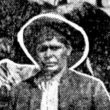Loading map...

Trackers were employed at Porters Retreat (approximately 70km south-south-east of Bathurst) from at least 1903 to 1916 and probably later[ref]SARANSW Police Salary Registers.[/ref]. The settlement was originally known as Glencoe and changed its name in about 1908 to Porters Retreat. As can be seen in the accompanying plan, by 1914 the tracker was living in a hut adjacent to the...
Learn More ►Sam Hall (also known as Sam Hull) was born in Gowen County (between Gilgandra and Coonabarabran) in about 1845. Little is known about his life personally or professionally. It is likely he was a tracker in the Coonamble district although his name is yet to be found in official records. In later years, he lived on the Aboriginal reserve at...
Learn More ►Alexander Ward (also known as Alexander King) was born at Bingebah Station on the western fringe of the Pilliga Scrub on 5 September 1887. He was the son of William King, an Aboriginal stockman born at Coonamble, and Jane Ward of Windsor in western Sydney. He married Stella Duncan of Coonamble at Burra Bee Dee Aboriginal Station in July 1916. ...
Learn More ►Charlie Hammond, son of Charlie Hammond Snr and Maria, was born on Wiradjuri country at Goolagong near Forbes in the 1870s. He was the tracker at Dubbo in 1902 and 1903. In May 1903 he helped arrest a man suspected of burning down a shed at Spicer's Creek to the east of Dubbo. The suspect's boots matched the prints at...
Learn More ►In 1862, police from the new amalgamated force were stationed at the new stone Court House and lock-up in Macquarie Street. A new station and lock-up were constructed in Brisbane Street in the early 1870s. Police barracks were constructed on Erskine Street in 1877 along with stables and quarters for the tracker. The police paddock was nearby at the northern...
Learn More ►Sam Bell was born at Hay in the late 1860s. Oral history suggests that he survived a massacre at Hay and later moved to Coonamble where he was employed as the tracker in 1889. Three years later he married Annie Duncan of nearby Bullarora Station. The couple had eight children, including May Bell who was born at Coonamble in...
Learn More ►Norman Walford, the last officially employed tracker in NSW, retired from the NSW Police on 3 May 1973 after a career of 25 years. He is well-remembered in Walgett today – there is a walkway in his honour along the edge of the Namoi River – and his wife, Mrs Gladys Walford (nee Kennedy) lives in town. And many Aboriginal...
Learn More ►Molong Police Station The only recorded tracker at Molong was Tommy who worked from 1883 to 1886. Nothing more about his life is currently known and trackers were not stationed at Molong after he left. A 20th century tracker with a link to Molong was Robert Henry Robinson who worked at Coonamble and Dubbo. His grandmother was Kitty Hanley, who,...
Learn More ►There were over 200 NSW police stations that employed Aboriginal trackers between 1862 and 1973. Many were concentrated in the central-west and north-west of the state, the agricultural and pastoral heartland of NSW. This is because one of the main jobs of trackers was to pursue sheep, cattle and horse thieves. Trackers sometimes lived in small huts out the back...
Learn More ►
 This website explores the history of Aboriginal trackers in NSW from 1862 when the current NSW Police Force was established through to 1973 when the last tracker, Norman Walford, retired. You can read about the lives of individual trackers and some of the incredible tracking feats they...
This website explores the history of Aboriginal trackers in NSW from 1862 when the current NSW Police Force was established through to 1973 when the last tracker, Norman Walford, retired. You can read about the lives of individual trackers and some of the incredible tracking feats they...

There were over 200 NSW police stations that employed Aboriginal trackers between 1862 and 1973. Many were concentrated in the central-west and north-west of the state, the agricultural and pastoral heartland of NSW. This is because one of the main jobs of trackers was to pursue sheep, cattle and horse thieves. Trackers sometimes lived in small huts out the back...
Learn More ►
Pathfinders book Pathfinders, A history of Aboriginal trackers in NSW, written by Dr Michael Bennett and published by NewSouth, is now available from all good bookstores. Click on the link below to order your copy. https://www.abbeys.com.au/book/pathfinders-a-history-of-aboriginal-trackers-in-nsw.do Early History Since the beginning of the colony, government agencies, explorers, surveyors and members of the general public called upon the tracking...
Learn More ►